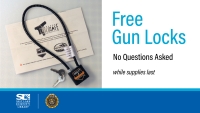Suicide Prevention at Salt Lake County Library
Salt Lake County Library, Utah
Innovation Synopsis
In the midst of an unprecedented, nationwide opioid and suicide epidemics, libraries stand at the center of their communities, ready to share information and connect people with life-saving resources. Salt Lake County Library recently added Naloxone and gun locks to their collection of free public resources.
Challenge/Opportunity
Opioid misuse and abuse is a nationwide epidemic impacting the lives of millions of Americans. In Utah, there are 7,000 opioid subscriptions filled every day. Over the last decade, prescription pain medications have been responsible for more drug deaths in Utah than all other drugs combined. Additionally, Utah experiences a suicide rate that continues to grow and is higher than the national rate. The free Naloxone rescue kits and gun locks are key to keeping community members safe and alive.
Key Elements of Innovation
In 2017, we began training staff on the signs of an overdose and proper response, to include administering Naloxone. All 18 branches received Narcan for in-house administration. In 2018, we identified the need for the public to easily and affordably access rescue kits. We partnered with Utah Naloxone, who donates (via a MOU) free rescue kits for us to distribute. We also partnered with Salt Lake Valley Suicide Prevention Coalition and the Utah Department of Public Safety to distribute free gun locks.
Achieved Outcomes
Community response to these offerings has been extremely positive. As a trusted community gathering space, we believe and have heard that people feel comfortable requesting the gun locks and rescue kit(s) from the library. If interested, they also have direct access to information about substance use disorder and treatment resources. Our librarians are at the ready to provide a reference interview should the patron desire. The ultimate anticipated outcome is reducing opioid overdose deaths and reducing suicides.

